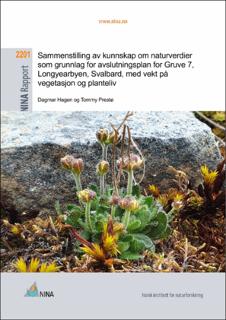Sammenstilling av kunnskap om naturverdier som grunnlag for avslutningsplan for Gruve 7, Longyearbyen, Svalbard, med vekt på vegetasjon og planteliv
Research report

Åpne
Permanent lenke
https://hdl.handle.net/11250/3037597Utgivelsesdato
2022Metadata
Vis full innførselSamlinger
- NINA Rapport/NINA Report [2341]
Sammendrag
Hagen, D. & Prestø, T. 2022. Sammenstilling av kunnskap om naturverdier som grunnlag for avslutningsplan for Gruve 7, Longyearbyen, Svalbard, med vekt på vegetasjon og planteliv. NINA Rapport 2201. Norsk institutt for naturforskning.
Store Norske Gruvedrift AS har besluttet å avslutte driften ved Gruve 7 ved Longyearbyen, Svalbard. Det skal lages en plan for avvikling av driften og for opprydding av områdene i og ved daganlegget på Gruve 7-fjellet. I henhold til Svalbardmiljøloven skal installasjoner fjernes og området tilbakeføres til natur. Som en del av grunnlaget for avslutningsplanen er det gjort en sammenstilling av kunnskapsgrunnlag for naturverdier, med hovedvekt på vegetasjon og planteliv.
Det er registrert 54 karplantearter og 39 mosearter i området (samlet fra befaring og tidligere funn). Det befarte området har en variasjon av naturtyper og mange av de vanligste Svalbardartene ble funnet i alle de befarte delområdene. Det er ikke registrert rødlista naturtyper i det befarte området.
Det ble registrert åtte rødlista karplantearter under befaringen og to andre var tidligere rapportert fra området; polararve, alperublom, polarrublom, tundrarublom, halvkulerublom, snøfrytle, grynsildre, snøgras, svalbardmure, svalbardsildre (Cerastium regelii, Draba fladnizensis, Draba micropetala, Draba pauciflora, Draba subcapitata, Luzula nivalis, Micranthes foliolosa, Phippsia algida, Potentilla insularis, Saxifraga ×svalbardensis). Alle rødlisteartene som ble funnet har kategori NT (nær truet) og årsaken til rødlisting er forventa endring i leveområder og populasjons-størrelse, primært som følge av klimaendringer. Det ble gjort en rekke funn av hver av de åtte artene og disse er stedfestet. Trolig finnes det flere individer av artene i området. Det er ikke gjort fullstendig inventering av moser i området; kun en vurdering basert på tidligere funn og kunnskap om artenes habitatkrav. Ved Gruve 7 er det er funnet fire mosearter som er norske ansvarsarter i europeisk sammenheng; svøpjøkelmose, skortemyggmose, blindlemenmose, tundrasliremose (Arctoa anderssonii, Cnestrum alpestre, Tetraplodon paradoxus, Timmia sibirica). Det er lite dokumentert kunnskap om arter i tilsvarende naturtyper i høytliggende områder i nærheten, så det vanskelig å si hvor representativt funnene rundt Gruve 7 er for platåfjellene i regionen, men arealet kan bli viktig dersom tilsvarende areal nede i dalene blir påvirket eller endret.
Det er forekomst av to sårbare livsmiljøer for dyreliv i tiltaksområdet; ferskvanndam og våtmark/myr. Det er noen sporadiske registreringer av fugl, men lite trolig at området har spesiell betydning for enkeltarter. Det finnes rein og rype, som er vanlige arter i Adventdalen og som inngår i etablerte overvåkingsprogrammer.
Prinsippene fra Store Norske sin tilbakeføring i Svea bør være grunnlag for utforming av detaljplaner for restaurering når omfanget av tilbakeføringen er fastsatt. Vellykket restaurering vil gi økt areal som er viktig for de rødlista og sjeldne artene som finnes i området. Hagen, D. & Prestø, T. 2022.Compilation of knowledge of biodiversity values as a basis for the mine closure plan for Gruve 7, Longyearbyen, Svalbard, with emphasis on vegetation and plant life. NINA Report 2201. Norwegian Institute for Nature Research.
Store Norske Gruvedrift AS has decided to close down the mining activity in Gruve 7 (Mine number 7) near Longyearbyen, Svalbard. According to the Svalbard Environmental Protection Act, the area must be cleared when the activity is terminated, including removing technical installations, waste and other remains, and restoration of the landscape. A closure plan is under development for ending mining operations, remove contamination and restore the surroundings of the plant on Gruve 7-fjellet. An assessment of the biological values and the potential for restoration has been conducted, as a part of compiling relevant knowledge for the closure plan and final decisions about the level of restoration.
In total 54 vascular plant species and 39 bryophyte species are recorded in the area (collected from field work and previous findings). The assessed area holds variety of ecosystem types and many of the most common Svalbard species were found in all the sub-areas visited. No red-listed habitat types registered in the inspected area.
Eight red-listed vascular plant species were recorded during the survey and two were previously reported from the area; Cerastium regelii, Draba fladnizensis, Draba micropetala, Draba pauciflora, Draba subcapitata, Luzula nivalis, Micranthes foliolosa, Phippsia algida, Potentilla insularis, Saxifraga ×svalbardensis. All the red-listed species belong to the red-list category NT (near threatened) and the reason for red-listing is an expected change in habitat and population size, primarily as as expected effects from climate change. A number of individuals were recorded and geolocated for each of the eight species. A complete inventory of bryophytes in the area has not been undertaken; this report is limited to an assessment based on previous findings and knowledge of the species' habitat requirements. At Gruve 7, four rare bryophyte species have been recorded, which are Norwegian species of responsibility in a European context; Arctoa andersonii, Cnestrum alpestre, Tetraplodon paradoxus, Timmia sibirica. Any other documentation of species occurrence in similar ecosystem types at this altitude nearby is lacking, and consequently it is hard to say how representative the findings are for the plateau mountains in this part of Svalbard.
Two sensitive habitat-types for wildlife are found the survey area; freshwater ponds and wetlands/marshes. Some occurrence data for birds exists from the area, but it is unlikely that the area has significant value for individual species. Reindeer and grouse uses the area regularly; both species are common in Adventdalen, and both included in ongoing monitoring programs.
Guidelines for ecosystem restoration in the Svea settlement should form the basis for planning and implementation of restoration in Gruve 7. Successful restoration will improve the ecological condition of the area and quality of habitat important for the red-listed and rare species in the area.